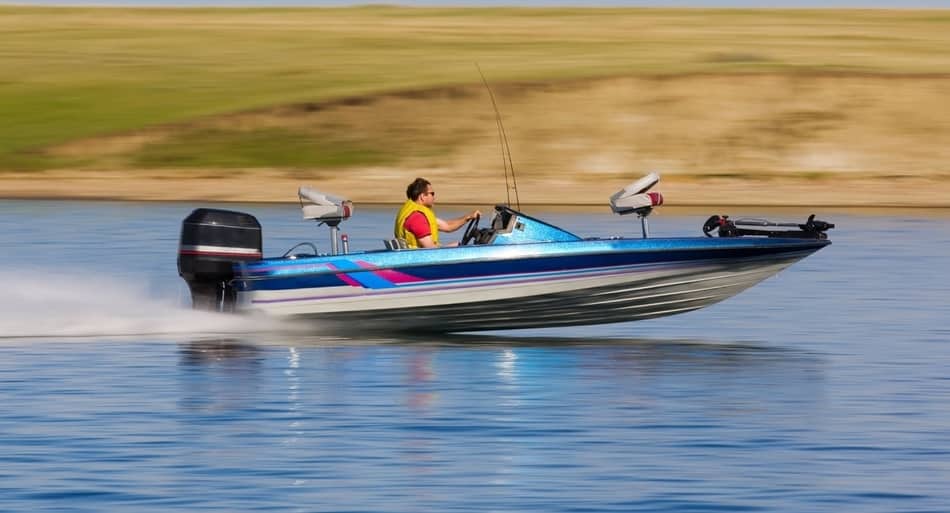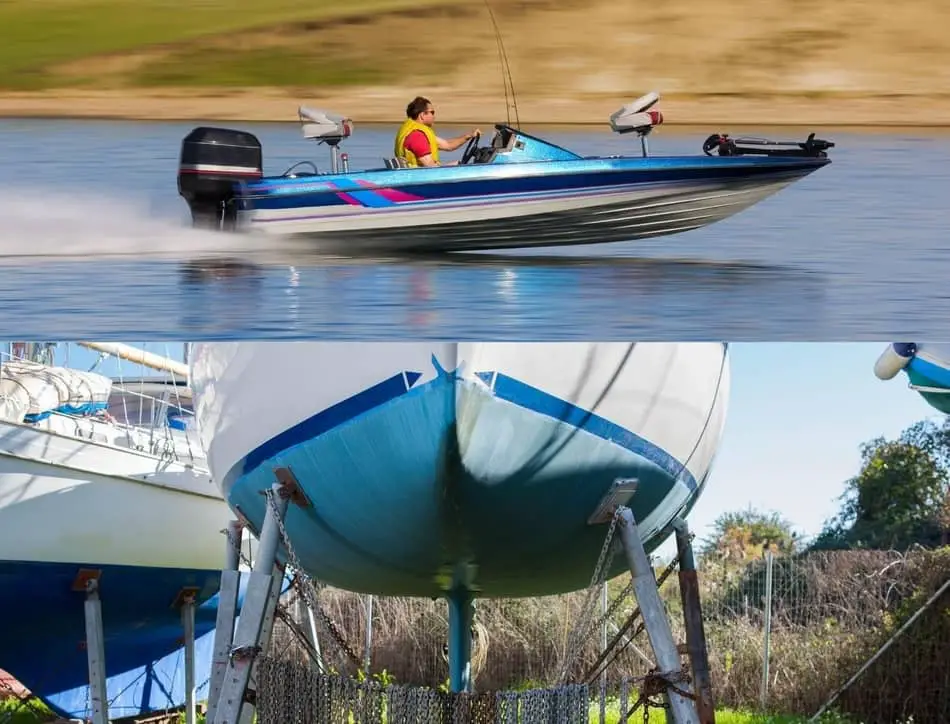Shallow water boating is not the same as deep water boating. Shallow water effects the boat speed, and you need to careful while boating in shallow waters as well. Here are some things that affect the speed of the boat in shallow waters.
Shallow waters decrease the boat speed because the water flowing under the boat moves quickly in shallow water, thereby creating high velocity. High velocity at a point in liquid creates low pressure; thus, the boat sinks more and displaces more water. So, the boat needs to push more water out of its way, which decreases the speed.
The draft of the boat will increase in shallow waters because, in shallow waters, the boat will be moving so close to the ground, and there is less space for the water to flow under the boat, which increases the water flow under the boat (velocity at that particular point in the water increases).
From Bernoulli’s principle, if the velocity is high at any point in the liquid, then there is a corresponding drop in the pressure at the point. Generally, the pressure is required to lift the boat in the water, and if that pressure decreases, the boat will sink more in water, thereby increasing the draft.
If the draft increases, then the boat displaces more water space in the water, and the boat needs to push more water out of its way. Pushing more water out of its (boats) way means, the boat takes more power and time to push that extra water out of its (boats) way. So, it will decrease the boat speed in shallow waters and takes more time to cover a small distance in shallow waters.
The main reason behind the decrease in the speed is due to the boat sinks more (or draft of a boat increases) in shallow waters than in normal (more depth) waters. Otherwise, the speed of the boat will not decrease if the draft of the boat doesn’t increase in shallow waters.
That increase in the draft is known as the squat effect, and it will cause the boat to sink more toward its stern side (generally). Meaning the stern side of the boat will be sunk more in water than in the bow side of the boat if the ground under the boat in straight or even. Again you need to level the boat for a safe ride (source).
Example of why water speed increases under the boat in shallow waters: Take an example of a water pipe; if you disturb the water flow by keeping the finger at the end of the pipe or covering the half of the pipe with a finger where water is coming out, then the water flow rate increases (velocity increases). The same phenomenon is working under the boat.
There is less space for water to flow under the boat in shallow water, which increases the velocity at the point, and decreases the pressure, thereby sinking the boat more in the water (or increasing the draft). So, the boat displaces more water, and it takes more time and power to push that extra water out of its way. Thus, the boat speed decreases in shallow waters (source).
Check my article on 13 Tips for boating in shallow waters (don’t worry, it will open in new tab) to prevent hitting the sandbar while boating in shallow waters.

How the boat hull affect the boat speed in shallow waters?

The boat hull design also affects the boat speed in shallow waters. The boat speed decreases in shallow waters if the boat has a displacement hull. Whereas, for a boat with planing hull design, the boat speed will increase in shallow waters.
It is due to the hull design. The displacement hull boat displaces more water and pushes more water out of its way. At the same time, the planning hull boat lifts the bow in the air, which makes a planning hull boat not to push any water out of its way with the bow.
Planing hull boats are designed like that, and they lift the front part of the boat (bow) in the air while boating, which eliminates the boat to push the water out of its way. Whereas the displacement hull boats can’t lift the boat bow in the air like a planing hull boat.
Generally, in shallow waters, the stern part of the boat will sink more in the water than the bow, which lifts the boat bow in the air. So, for a planing hull boat, the hull is already elevated in the air, which makes the boat go faster in the shallow waters without any extra power.
Even for the displacement hull boat, the bow part of the boat will rise in the air. But, the displacement hull boats are not designed like that (lifting the boat bow in the air and boating). And, you need to level the boat properly for a safe ride. So, the displacement hull boats go slower than planing hull boats in shallow waters.
Even in normal waters (deep waters), the planing hull boats go faster than the displacement hull boat because the displacement hull boat pushes the water out of its way, and the planing hull boats will not at all the pushes the water out of its way. So, the displacement hull boat goes slower than planing hull boat in shallow waters.
Check my article on Essential factors that affect the boat speed (don’t worry, it will open in new tab) to know more about how the boat hull design affects the boat speed.
Tables showing how shallow waters affect the boat speed
Below, I showed how different boat speeds are affected in shallow waters. Check my article on Why are boats slower than cars? (don’t worry, it will open in new tab) to know what affects the boat to travel at the speed of a car.
The decrease in the speed of a boat moving at 5 knots in shallow water
The below table shows how the hull or displacement speed of a boat moving at 5 knots will get affected by a decrease in the water depth. All those values are typical (or average values), and those values may vary a little bit for each boat (source).
| Boat speed (in knots) | Water depth (in feet) | % decrease in the speed |
| 5 kts | 14 feet + | No loss |
| 5 kts | 6 feet | 1 % loss |
| 5 kts | 2 feet | 4 % loss |
| 5 kts | – | – |
The decrease in the speed of a boat moving at 10 knots in shallow water
The below table shows how the hull or displacement speed of a boat moving at 10 knots will get affected by a decrease in the water depth. All those values are typical (or average values), and those values may vary a little bit for each boat (source).
| Boat speed (in knots) | Water depth (in feet) | % decrease in the speed |
| 10 kts | 55 feet + | No loss |
| 10 kts | 24 feet | 1 % loss |
| 10 kts | 14 feet | 4 % loss |
| 10 kts | 9 feet | 14 % loss |
The decrease in the speed of a boat moving at 15 knots in shallow water
The below table shows how the hull or displacement speed of a boat moving at 15 knots will get affected by a decrease in the water depth. All those values are typical (or average values), and those values may vary a little bit for each boat (source).
| Boat speed (in knots) | Water depth (in feet) | % decrease in the speed |
| 15 kts | 124 feet + | No loss |
| 15 kts | 55 feet | 1 % loss |
| 15 kts | 31 feet | 4 % loss |
| 15 kts | 20 feet | 14 % loss |
The decrease in the speed of a boat moving at 20 knots in shallow water
The below table shows how the hull or displacement speed of a boat moving at 20 knots will get affected by a decrease in the water depth. All those values are typical (or average values), and those values may vary a little bit for each boat (source).
| Boat speed (in knots) | Water depth (in feet) | % decrease in the speed |
| 20 kts | 220 feet + | No loss |
| 20 kts | 98 feet | 1 % loss |
| 20 kts | 55 feet | 4 % loss |
| 20 kts | 35 feet | 14 % loss |
Key takeaways
While boating in shallow waters, the boat speed decreases because the water flowing under the boat moves quickly in shallow water, thereby creating high velocity. High velocity at any particular point in the liquid creates a low pressure (Bernoulli’s principle); thus, the boat sinks more (or draft increases) and displaces more water. So, the boat needs to push more water out of its way, which slows down the boat speed in shallow waters.
Not all types of boats go faster in shallow waters. Planning hull boats go faster in shallow water because the planing hull boat lifts the boat bow in air, which prevents pushing all the water out of its way like a displacement hull boat. So, the planing hull boat goes faster in shallow waters.
Displacement hull boats go slowly or won’t go faster in shallow waters because the displacement hull boat displaces more water (because the boat sinks more or draft increases in shallow waters), which makes the boat to push more water out of its way. So, the displacement hull boat goes slowly in shallow waters.
